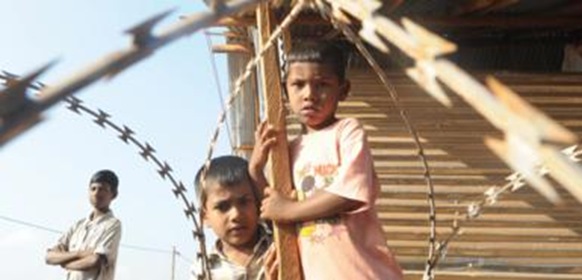 Sri Lankan authorities appear to be building permanent camps to house many of the 300,000 refugees from the last phase of the war with the Tamil Tiger rebels, despite promising to resettle 80 per cent of them by the end of the year.
Sri Lankan authorities appear to be building permanent camps to house many of the 300,000 refugees from the last phase of the war with the Tamil Tiger rebels, despite promising to resettle 80 per cent of them by the end of the year.
Aid workers have told The Times that permanent buildings are being erected at the Manik Farm site where the UN says that 230,000 of the refugees are being held after the Tigers’ defeat in May.
The aid workers said that they were able to do humanitarian work in four of six zones at Manik Farm but were barred from two others, including the mysteriously named Zone Zero.
“We’re not allowed to work in these areas,” said Rajinda Jayasinghe, the head of Relief International in Sri Lanka. “But you can see from the outside proper brick-walled buildings going up.” Some aid workers said that the site was fast becoming Sri Lanka’s second biggest city after the capital, Colombo, with schools, clinics and banks, where refugees have deposited more than a billion rupees.
“In zones where the Government works there are permanent shelters: cement floors, timber structures, corrugated iron roofs,” said one aid worker, who asked not to be identified. “These are designed to last years.”
The Government originally proposed holding the Tamil refugees in “welfare villages” for up to three years to check that they were not Tigers, and to clear their villages of mines.
After donor nations protested and Tamil MPs and activists compared the barbed wire enclosures to concentration camps, the Government promised to resettle 80 per cent of the refugees by the end of this year.
Gotabaya Rajapaksa, the Defence Secretary, who is also the President’s brother, renewed the promise last week.Aid workers said that the new structures violated UN guidelines on temporary refugee shelters, and suggested that the Government meant to hold refugees for much longer.
UN sources also said that the Government had been using refugees to build the permanent structures without paying them — a possible violation of UN guiding principles on internal displacement.
Refugees involved in the building had asked to be paid but the Government refused, the UN sources said.
Aid groups’ concerns over the buildings grew last month when the Government proposed giving people in each tent two bags of cement to build their own floors, a leaked document obtained by The Times shows.
At a meeting on June 15, a group of non-governmental organisations providing shelter in the camps expressed “strong reservations” about the plans, according to the document. They said that the proposed concrete flooring was too expensive, provided no protection against flooding and violated UN guidelines on temporary refugee shelters. “The use of concrete flooring is inconsistent with temporary structures and is one of the recognised criteria of a semi-permanent structure,” the document said. “The use of concrete or screed flooring suggests a commitment by the SLA [Sri Lankan authorities] to increased longevity of the IDP [internally displaced person] sites.”
A spokesman for the Sri Lankan High Commission in London denied that the Government was building permanent structures in the camps.
“Concrete is laid only for the safety and to maintain cleanliness. It should not be considered as an indication for permanency,” he said. “People will be resettled as fast as possible. [The] 180-day target is a huge challenge. However, the Government will accomplish it with the help of the UN and friendly foreign countries.”
He said that the Government had already resettled 600 families and the army had cleared 100,000 landmines.
(For updates you can share with your friends, follow TNN on Facebook and Twitter )
